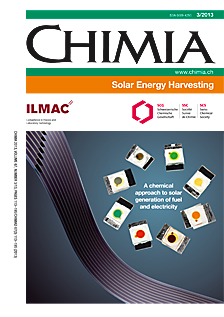Everything you always wanted to Know about Black Dye (but Were Afraid to Ask): A DFT/TDDFT Investigation
DOI:
https://doi.org/10.2533/chimia.2013.121Keywords:
Acid-base properties, Black dye, Dft, Electronic and optical properties, Tio2 adsorptionAbstract
We report an exhaustive theoretical and computational investigation of the electronic, optical, redox and acid-base properties, along with the adsorption mode on TiO2, of Black Dye (BD), the prototypical panchromatic dye for solar cell applications. We investigated in detail the variation of the relevant dye properties as a function of the solution pH, corresponding to the stepwise deprotonation of the carboxylic groups. Our results reproduced the expected blue-shift of the optical absorption spectrum and the experimental trend of oxidation potentials by increasing pH, which turned both out to be in excellent agreement with experimental values. Also, our calculated excited state oxidation potential is in good agreement with available experimental data. We then looked at the pKa of the various deprotonation steps, finding lowest pKa values for the stepwise dissociation of three protons of 2.71, 3.69 and 5.20, in excellent agreement with experimental pKa values of 3 and 5, for two and one protons dissociation, respectively. We finally investigated the adsorption of BD on TiO2, finding the most stable adsorption to occur via two dissociated monodentate carboxylic groups. Inspection of the electronic structure and alignment of energy levels for N719 and BD revealed a reduced driving force for electron injection in the latter dye, which could possibly lead to energetically unfavorable electron transfer from the excited dye to the TiO2 conduction band. Our results may constitute a reference study for future investigations and optimization of BD-based dye-sensitized solar cells.Downloads
Published
2013-03-27
Issue
Section
Scientific Articles
License
Copyright (c) 2013 Swiss Chemical Society

This work is licensed under a Creative Commons Attribution-NonCommercial 4.0 International License.
How to Cite
[1]
S. Fantacci, M. G. Lobello, F. De Angelis, Chimia 2013, 67, 121, DOI: 10.2533/chimia.2013.121.







